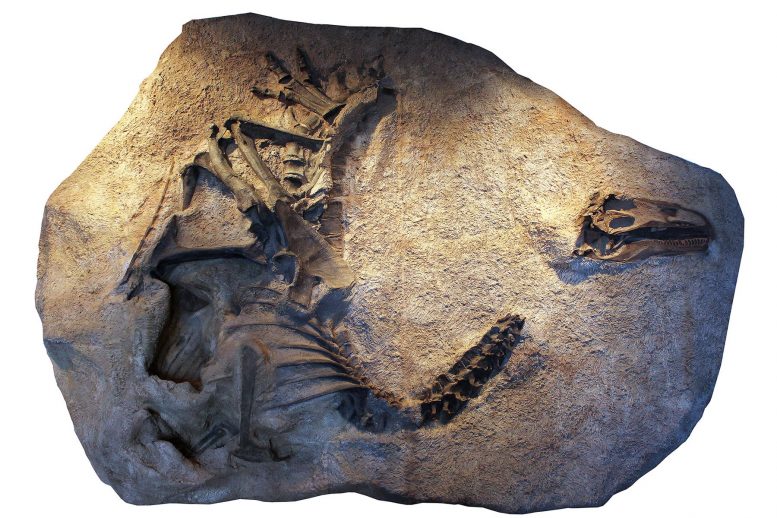A remarkable new species of meat-eating dinosaur has been unveiled at the Natural History Museum of Utah. Paleontologists unearthed the first specimen in early 1990s in Dinosaur National Monument in northeastern Utah. The huge carnivore inhabited the flood plains of western North America during the Late Jurassic Period, between 157-152 million years ago, making it the geologically oldest species of Allosaurus, predating the more well-known state fossil of Utah, Allosaurus fragilis. The newly named dinosaur Allosaurus jimmadseni, was announced today (January 24, 2020) in the open-access scientific journal PeerJ.
The species belongs to the allosauroids, a group of small to large-bodied, two-legged carnivorous dinosaurs that lived during the Jurassic and Cretaceous periods. Allosaurus jimmadseni, possesses several unique features, among them a short narrow skull with low facial crests extending from the horns in front of the eyes forward to the nose and a relatively narrow back of the skull with a flat surface to the bottom of the skull under the eyes. The skull was weaker with less of an overlapping field of vision than its younger cousin Allosaurus fragilis. Allosaurus jimmadseni evolved at least 5 million years earlier than fragilis, and was the most common and the top predator in its ecosystem. It had relatively long legs and tail, and long arms with three sharp claws. The name Allosaurus translates as “different reptile,” and the second part, jimmadseni, honors Utah State Paleontologist James H. Madsen Jr.
Following an initial description by Othniel C. Marsh in 1877, Allosaurus quickly became the best known — indeed the quintessential — Jurassic theropod. The taxonomic composition of the genus has long been a debate over the past 130 years. Paleontologists argue that there are anywhere between one and 12 species of Allosaurus in the Morrison Formation of North America. This study recognizes only two species — A. fragilis and A. jimmadseni.
“Previously, paleontologists thought there was only one species of Allosaurus in Jurassic North America, but this study shows there were two species — the newly described Allosaurus jimmadseni evolved at least 5 million years earlier than its younger cousin, Allosaurus fragilis,” said co-lead author Mark Loewen, research associate at the Natural History Museum of Utah, and associate professor in the Department of Geology and Geophysics at the University of Utah led the study. “The skull of Allosaurus jimmadseni is more lightly built than its later relative Allosaurus fragilis, suggesting a different feeding behavior between the two.”
“Recognizing a new species of dinosaur in rocks that have been intensely investigated for over 150 years is an outstanding experience of discovery. Allosaurus jimmadseni is a great example of just how much more we have to learn about the world of dinosaurs. Many more exciting fossils await discovery in the Jurassic rocks of the American West,” said Daniel Chure, retired paleontologist at Dinosaur National Monument and co-lead author of the study.
George Engelmann of the University of Nebraska, Omaha initially discovered the initial skeleton of the new species within Dinosaur National Monument in 1990. In 1996, several years after the headless skeleton was collected, the radioactive skull belonging to the skeleton using a radiation detector by Ramal Jones of the University of Utah. Both skeleton and skull were excavated by teams from Dinosaur National Monument.
“Big Al,” another specimen belonging to the new species, was discovered in Wyoming on United States Bureau of Land Management (BLM) land in 1991 and is housed in the collections of the Museum of The Rockies in Bozeman, Montana. Previously thought to belong to Allosaurus fragilis, “Big Al” was featured in the BBC’s 2001 “Walking with Dinosaurs: Ballad of Big Al” video. Over the last 30 years, crews from various museums have collected and prepared materials of this new species. Other specimens include “Big Al Two” at the Saurier Museum Aathal in Switzerland and Allosaurus material from the Dry Mesa Quarry of Colorado at Brigham Young University.
“This exciting new study illustrates the importance of continued paleontological investigations on public lands in the West. Discovery of this new taxon of dinosaur will provide important information about the life and times of Jurassic dinosaurs and represents another unique component of America’s Heritage,” said Brent Breithaupt, BLM regional paleontologist.
Early Morrison Formation dinosaurs were replaced by some of the most iconic dinosaurs of the Late Jurassic
Allosaurus jimmadseni lived on the semi-arid Morrison Formation floodplains of the interior of western North America. The older rocks of the Morrison Formation preserve a fauna of dinosaurs distinct from the iconic younger Morrison Formation faunas that include Allosaurus fragilis, Diplodocus and Stegosaurus. Paleontologists have recently determined that specimens of this new species of dinosaur lived in several places throughout the western interior of North America (Utah, Colorado and Wyoming).
Study summary
Dinosaurs were the dominant members of terrestrial ecosystems during the Mesozoic. However, the pattern of evolution and turnover of ecosystems during the middle Mesozoic remains poorly understood. The authors report the discovery of the earliest member of the group of large-bodied allosauroids in the Morrison Formation ecosystem that was replaced by Allosaurus fragilis and illustrate changes acquired in the genus over time. The study includes an in-depth description of every bone of the skull and comparisons with the cranial materials of other carnivorous dinosaurs. Finally, the study recognizes just two species of Allosaurus in North America with Allosaurus fragilis replacing its earlier relative Allosaurus jimmadseni.













![Hotstar Premium Cookies 2019 [*100% Working & Daily Updated*] Hotstar Premium Cookies 2019 [*100% Working & Daily Updated*]](https://tahav.com/wp-content/uploads/2019/11/Hotstar-Premium-Cookies-Free-100x70.jpg)



